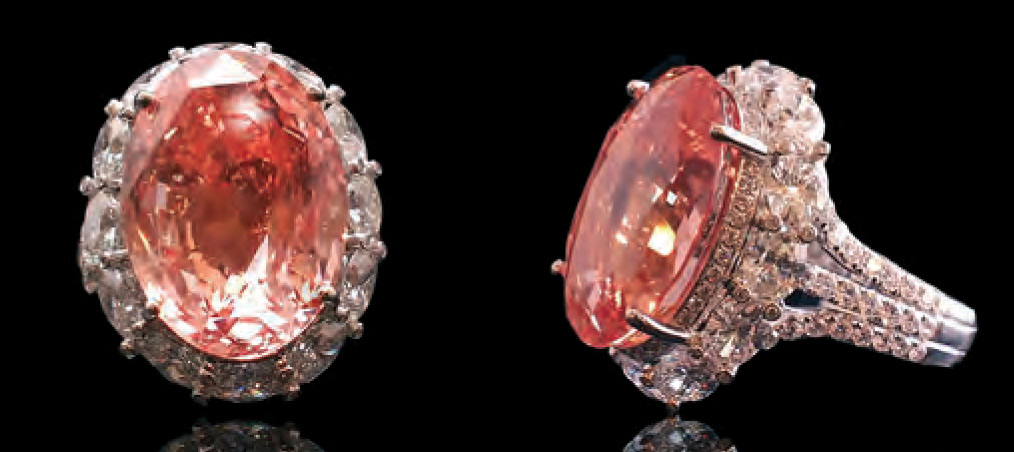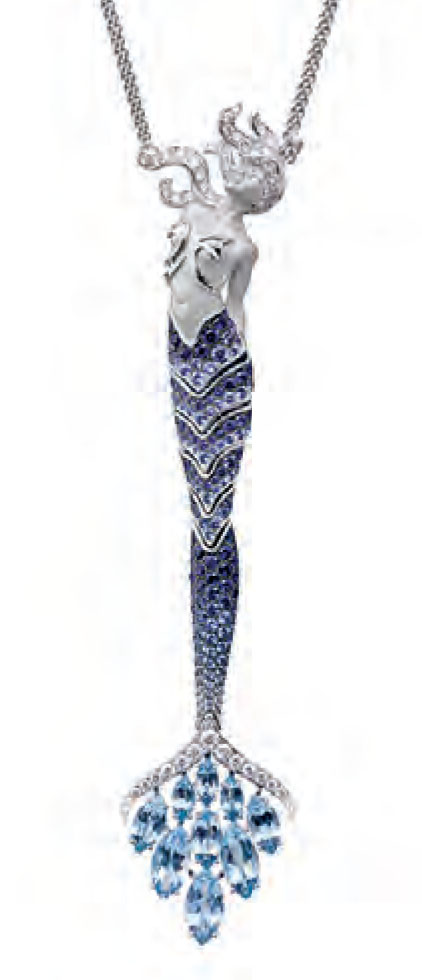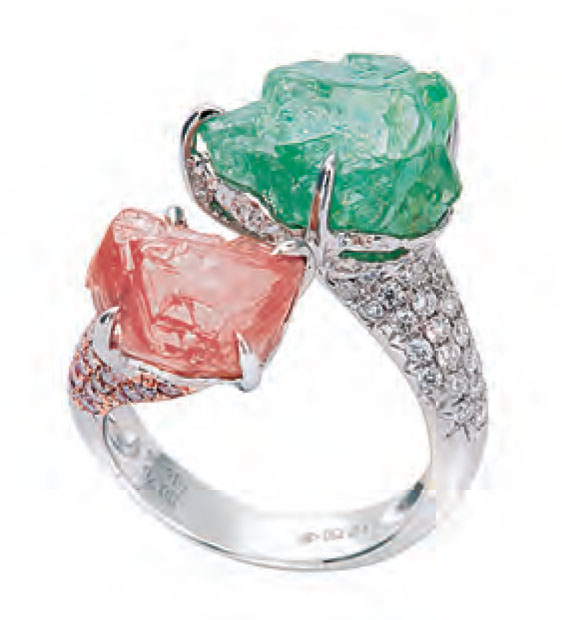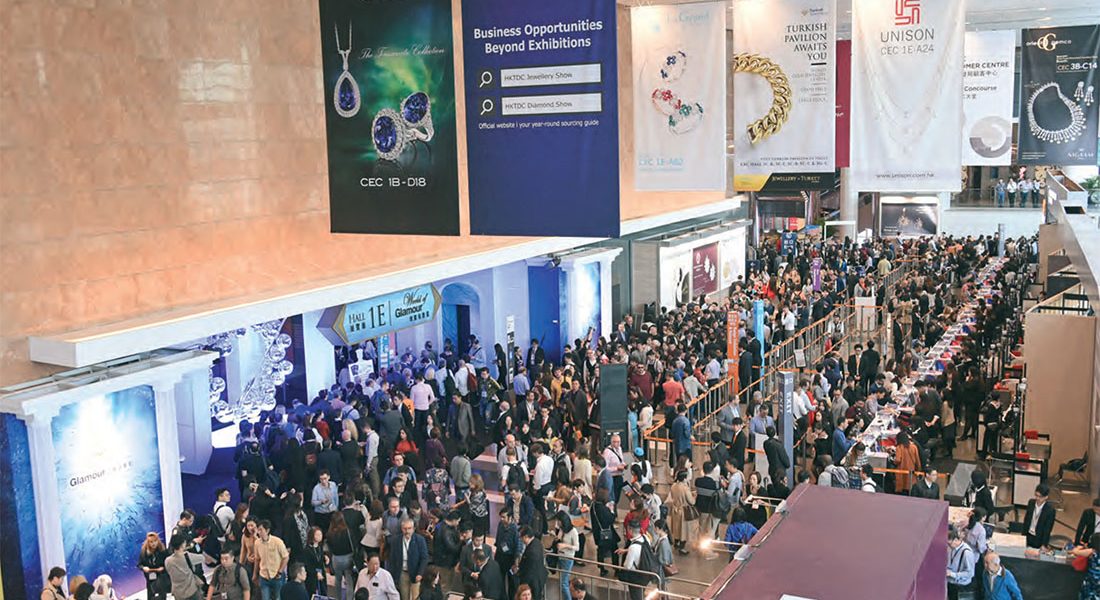Hong Kong has proven once again that the city is the world’s number one destination for gems and jewellery. More than 90,000 buyers from around the world came to see the wares of more than 4,600 exhibitors at the recent twin gem and jewellery shows organised by the Hong Kong Trade Development Council (HKTDC).

The 6th Hong Kong International Diamond, Gem & Pearl Show (IDGPS), from February 26th to March 2nd, and the 36th Hong Kong International Jewellery Show (IJS), from February 28th to March 4th, were both organised by the HKTDC. They featured more than 4,600 exhibitors and welcomed a record number of over 90,000 buyers from 141 countries and regions, up 4% over the previous year. More than 35,000 buyers attended the IDGPS, while about 55,000 visited the IJS.
“By bringing together exhibitors from all corners of the world and showcasing the finest jewellery and jewellery raw materials, the two HKTDC shows serve not only as a one-stop promotion and sourcing platform for the industry, but also make Hong Kong a top jewellery trading and sourcing hub for buyers globally,” stated Benjamin Chau, HKTDC deputy director. “In the midst of the current economic instability, these jewellery trade shows help brace the industry for the challenges ahead.”
Chau went on to add that in the face of an “uncertain global economy, jewellers have been actively enhancing their design and R&D capabilities in recent years. The growing diversity of designs and materials was demonstrated in the exhibits at this year’s shows, which successfully attracted the attention of global buyers. We are delighted that the buyer attendance at the two shows reached a record high, with a satisfactory growth in attendance from emerging markets such as Mainland China, India and ASEAN countries such as the Philippines, Singapore, Malaysia and Indonesia.”
International Diamond, Gem & Pearl Show
The registration lines at the IDGPS were so long on the first day of the exhibition that many buyers waited up to two hours to get their badge. Was the wait worth it? Yes, was the resounding answer, as buyers quickly spread out over the many halls at Asia World Expo, located near the airport, to see the products featured at some 2,000 booths. From inexpensive gem beads to multi-million-dollar gemstone and diamond suites, there was something for everyone.
In the diamond section, the mood was a bit subdued, although some dealers felt that this show was better than the event last September, which suffered as a result of the typhoon. Despite the busy traffic, sales were a bit on the slow side, especially lowerpriced goods, due to a surplus in this category, according to some dealers. However, others reported reasonably good sales in the lowervalue items, but a hesitation by buyers for higher-priced goods.
On the more unusual side of the diamond story was the faceted “Buddha Diamond”, an original cut offered by Antwerp’s The Buddha Diamond Company, which attracted attention. On the other hand, dealers in coloured diamonds indicated a strong demand for pink, orange and blue stones with prices that are continuing their upward trend.
In the pearl halls, everything was on display, from inexpensive strands of freshwater pearls to very high-end South Sea pearls in a variety of colours, with a large presence of Japanese exhibitors. This year, with support from Japan’s External Trade Organisation and the ConsulateGeneral of Japan in Hong Kong, the HKTDC collaborated with the Japan Pearl Exporters’ Association and the Japan Pearl Promotion Society to invite Japan as the shows’ partner country for the first time. Between the two shows, about 130 exhibitors promoted Japan’s cultured pearls and pearl jewellery to buyers from around the world. Other than regular fine pearl jewellery, exhibitors also showcased rare Tsushima Blue and Tsushima Green pearls.

As for coloured gemstones, a series of national pavilions as well as the ICA pavilion and the Treasures of Nature pavilion offered a wide variety of types, colours and qualities. According to a number of dealers, the hottest colours are pinks, mainly spinel, ruby (both Burmese and Mozambique) and sapphire, but also morganite and peach-toned padparadscha sapphire, which are said to be especially appreciated in Asian markets.
Unheated stones of all sorts continue to be popular, with prices rising in response to diminishing supplies. Blue and green gems were also appreciated by buyers, especially Paraiba tourmaline, aquamarine, emerald and green tourmaline, which were featured by many exhibitors. Less common bluish-green and teal sapphires also drew attention. Australian opal seems to be making a comeback, as are its prices, which several dealers indicated are approaching the peak levels seen during the 1980s and 1990s. Overall, the majority of dealers expressed cautious optimism about the coloured gem industry going forward.
The International Jewellery Show
Held at the Hong Kong Convention and Exhibition Centre, the IJS is a signature event of the global jewellery industry, and this year did not disappoint. With a series of themed and national pavilions, including the new Amber Jewellery Pavilion, as well as the Antique & Vintage Jewellery Galleria and the always-interesting Designer Galleria, a lavish assortment of jewels could be found.

Among the most prestigious pieces were those on display in the Hall of Extraordinary. Exhibitors in this premium zone offered rare and luxury collections appealing to upscale buyers from around the globe. In terms of sales, the majority of exhibitors polled indicated that traffic and sales were up over last year, with new buyers coming from China, Taiwan and the US.
While it is nearly impossible to discern general trends at the show, given the large variety, a few design directions were nonetheless noted. Nature-inspired themes were again popular, with butterflies taking the lead, although there was no shortage of floral motifs in a variety of designs. This year, it seemed that jewels with a story were more prevalent, and included pieces ranging from polar bears and climate change to Asian-inspired themes. Titanium jewellery was seen at a number of booths while enamelled jewels continue to be a significant segment of the global industry. Coloured gemstone pieces formed the basis of most high-end jewels, while a minor “natural” trend was observed with the use of rough gems and druzies combined with gold and silver.

As is traditional, the design competitions incited a great deal of interest from attendees. The 20th Hong Kong Jewellery Design Competition showcased the skills of some of Hong Kong’s most talented young jewellers. This year’s competition spotlighted creativity and craftsmanship under the theme “Be Connected, Be United”. The latest edition of the competition received close to 200 entries in two categories: the Open Group and Student Group. The panel consisted of seven judges from various sectors, who evaluated the entries based on: (1) creativity and innovation; (2) aesthetics, craftsmanship and wearability; (3) topic relevance; and (4) marketability (applicable only to the Open Group). Among the creative entries were a school of fish assembled on a brooch, symbolising the power of unity, and a mix of Chinese and Western tableware miniatures set on a pair of earrings to represent cultural integration.
Winners of the 2019 International Jewellery Design Excellence Award (IJDE)—a biennial competition sometimes dubbed the “Oscars of the jewellery industry”—were announced at an award presentation during the IJS. A total of 137 award-winning designers from 21 countries and regions participated in this year’s competition, organised by the HKTDC, along with the Hong Kong Jewellers’ & Goldsmiths’ Association, Hong Kong Jewellery & Jade Manufacturers Association, Hong Kong Jewellery Manufacturers’ Association and Diamond Federation of Hong Kong, China Ltd.
American designer Aleksandr Maryaskin won the highest honour, “Champion of the Champions”, with his egg-shaped desktop decoration named “Discovery of Eggcellance”. The “egg” can be twisted open to reveal a miniature church complex inspired by a traditional church the designer helped restore while living in Ukraine. Hong Kong designer Sarah Zhuang captured the “Innovative and Uniqueness in Design Award” for her “Urban Reflection”, which incorporates Hong Kong’s world-renowned skyline in a set of four rings, depicting the city’s diverse architecture with ultra-modern skyscrapers juxtaposed against historical buildings.
New Technology And The Jewellery Industry

Among the many informative seminars at the IDGPS and the IJS was a forum where industry experts came together to discuss how new technology is changing different aspects of the jewellery industry, including design, manufacturing, marketing and retail, and what the trends indicate for the next decade.
The rise of computer-aided design (CAD) and computeraided manufacturing (CAM) has brought about a revolutionary transformation of the jewellery industry, said Thomas Ng, core member of the International Association of Jewellery Merchandise Planning Professionals and representative of French software developer 3DESIGN. He explained that new technologies using CAD/CAM software have helped improve efficiency and reduce costs. “It enables companies to break the distance barrier and allows them to complete a design in one hour instead of 10 days and release it immediately around the world,” he said.
Fundamental changes have also been seen in sales channels as the software used in online apps allows clients to custom-design their own jewellery, changing the colour, shape, stone and metal as they require. Meanwhile, new social media platforms are allowing companies to publish videos of their products instantly to target specific groups.
At the manufacturing level, the advanced development of 3D printing has largely benefited jewellers in the areas of prototypemaking and mass production, explained Robin Wang, co-founder of Jiangsu Totus Technology Co. Ltd. “The key benefit is fast turnaround,” he said, adding that new printing technologies have largely shortened the manufacturing cycle, allowing higher precision and resulting in faster delivery times.
On the design side, a few exhibitors showcased jewellery that uses information technology (IT) to create smart jewels. One such company is Taiwan-based Wenwen, which showcased jewels that become tools for messaging or even emergency alerts. Its waterproof smart chips can be embedded into high-density ceramics and gemstones, or set onto jewellery pieces such as bracelets, necklaces and earrings.

Optimistic Outlook
During the shows, the HKTDC commissioned an independent onsite survey that interviewed 1,347 exhibitors and buyers to gauge their business expectations and views on the industry’s latest developments.
With the US-China trade conflict weighing on the global economy, the survey found that 60% of respondents were neutral or positive about their export performance over the near term, while close to 80% were optimistic or neutral about the prospects of Mainland China and the United States resolving their trade issues.
In terms of overall sales, 61% of respondents said they expected to see no change this year, with 33% expecting sales to increase and only 6% anticipating a sales decline. This suggests that the jewellery industry is generally optimistic about the business outlook, despite the current global uncertainties. The survey also found that 47% of respondents expect production or sourcing costs to rise, while 68% anticipate that prices will remain unchanged, 25% expect prices to rise, and 7% believe that prices will drop.
In terms of specific product categories, most respondents expect trendy fashion jewellery to have the greatest market potential (71%), followed by designer jewellery (67%), jewellery for weddings and special occasions (64%) and precious jewellery (62%). Looking at the retail price range, most (63%) expect products priced from $501 to $1,000 to have the greatest potential, followed by products in the $1,001-$5,000 price range (54%) and those in the mid-to-low price range of $101-$500 (53%).
As for the most popular product materials in 2019, the survey found that 54% favoured karat white gold, followed by karat rose gold (39%), platinum (36%) and karat yellow gold (36%). As for gemstones, diamonds were the most popular (54%), followed by aquamarine (18%), jade (17%) and pearls (15%).
When queried about growth prospects for emerging markets over the next two years, many considered the prospects of Mainland China to be the most promising (64%), followed by ASEAN countries (42%), Eastern Europe (33%) and Russia (33%). For traditional markets, the respondents viewed Hong Kong (55%) and Western Europe (55%) most favourably, followed by North America (50%) and Japan (40%).
Next year’s HKTDC-organised twin shows will take place from March 2nd-6th, 2020, for the IDGPS and March 4th-8th, 2020, for the IJS.


